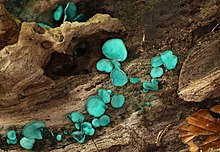Chlorociboria aeruginosa
| Chlorociboria | |
|---|---|
 |
|
| Chlorociboria sp. | |
| Scientific classification | |
| Kingdom: | Fungi |
| Division: | Ascomycota |
| Subdivision: | Pezizomycotina |
| Class: | Leotiomycetes |
| Order: | Helotiales |
| Family: | Helotiaceae |
| Genus: |
Chlorociboria Seaver ex Ramamurthi, Korf & L.R. Batra |
| Type species | |
|
Chlorociboria aeruginosa (Oeder) Seaver ex C.S. Ramamurthi |
|
| Species | |
|
17, see text |
|
17, see text
Chlorociboria is a genus of fungi within the subphylum Pezizomycetes. The genus includes 17 species.
Two common temperate zone species, Chlorociboria aeruginascens and Chlorociboria aeruginosa, can only reliably be distinguished by microscopic examination. Chlorociboria aeruginosa has larger spores (9–15 µm × 1.5–2.5 µm) and the worm-like cells of the outer surface are rough, unlike the commoner C. aeruginascens, of which the spores are 6–10 µm × 1.5–2 µm.
The hyphae and fruiting bodies of all species make xylindein, a secondary metabolite that stains the substrate wood blue-green, with "green oak" being a valued commodity in woodworking. The blue-green pigmented wood is featured in "Tunbridge ware."
Blue-green stain is evident year-round, with ascocarp production occurring from summer to fall.
...
Wikipedia
